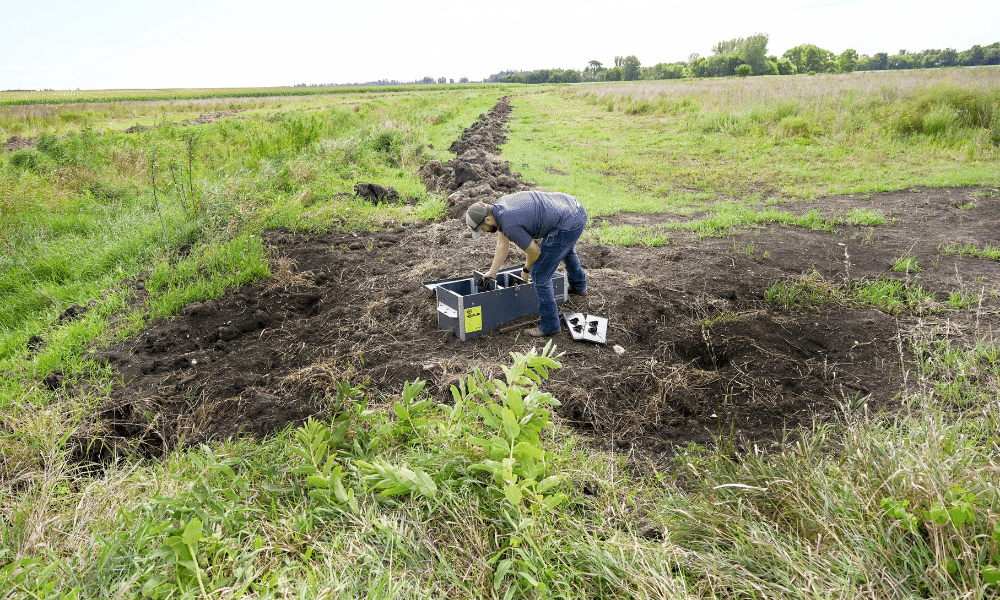
Corey McKinney, a conservationist with the Iowa Soybean Association, checks water levels in a newly installed saturated buffer along Rock Creek near Osage. (Joseph L. Murphy/Iowa Soybean Association)
Making progress in water quality
October 12, 2020 | Bethany Baratta
From a window in his rural Lake City home, Mark Schleisman can see the North Raccoon River. It’s not only a tributary feeding the Mississippi River, but a place where his kids enjoy fishing. It’s an extension of the landscape that Schleisman has worked decades protecting using various soil and water conservation efforts.
He knows the cover crops, bioreactors, grass waterways and filter strips are benefitting water quality. One sign is the quality of fish his children catch.
“When I was a kid, the water quality was not very good in the river,” Schleisman says. “We fished for catfish and got mostly carp. Now, my kids catch bass and walleye – nice game fish out of the water.”
He sees the water quality improve through the various testing he’s been involved with through the Iowa Soybean Association (ISA). Cover crops sequester nutrients on his fields, keeping valuable inputs there for the next crop.
Tile monitoring through ISA validates progress made in water quality.
“I really appreciate ISA doing this monitoring because it puts a real number behind the practice,” he says.
A strategic approach
Long before the Iowa Nutrient Reduction Strategy was implemented, ISA was working with farmers to reduce nutrient loading in Iowa’s streams and rivers. ISA recognizes the role the agriculture industry has in positively affecting water quality for downstream partners.
“Farmers in watersheds have the first opportunity to influence what stays on the farm and what’s released,” says Roger Wolf, director of innovation and integrated solutions for ISA’s Research Center for Farming Innovation.
He says a suite of practices can change the flow of water. Each practice – whether within a field or edge-of-field – can be a “barrier to the impact of the raindrop,” he says.
The Iowa Nutrient Reduction Strategy, which ISA provided technical expertise in coordination with the Iowa Department of Agriculture and Land Stewardship, the Iowa Department of Natural Resources, and Iowa State University College of Agriculture and Life Sciences, has heightened the discussion of water quality since it was released in May 2013.
The Iowa plan was developed in response to the 2008 Gulf Hypoxia Plan, which called for the states bordering the Mississippi River to reduce the amount of nitrogen and phosphorus reaching the gulf by at least 45%.
“The key of the nutrient reduction strategy is to crack the nut on capturing big reductions in nutrient losses,” Wolf says.
Various practices and tools are helping the state achieve the goals set in the Iowa Nutrient Reduction Strategy. ISA Conservationist Corey McKinney helps farmers determine which tools are most appropriate for their farms.
“I’m here for the farmer,” McKinney says. “We talk through the goals of the farm, look at where a practice could make the most sense and work at getting those practices implemented.”
A further evaluation of Schleisman’s farm, for example, determined that additional bioreactors could be constructed to filter water before reaching the Mississippi River. As a result, three bioreactors will be implemented this year.
Schleisman is also excited about a water recycling project being engineered for his farm. With technical assistance from Chris Hay, ISA senior manager of production systems innovation, Schleisman will recycle water that flows from his fields by storing it for irrigation when rainfall is scarce.
“We’re taking tile water that potentially has unused nutrients in it and reapplying those back onto the field to raise a crop, rather than losing those nutrients downstream,” Schleisman says.
Sometimes, adding a project isn’t the right fit for the farm or the farmer, McKinney says. Farmers can then rely on ISA’s agronomy and analytical experts to make the most out of every acre through improved cropping systems and analytical tools.
The integrated approach to water quality is key to reaching the “audacious” goals of the strategy, Wolf says.
“Using this integrated approach within ISA’s Research Center for Farming Innovation, we’re bringing together on-farm research along with agronomic and analytical data to build soil health and improve water quality,” Wolf says.
There are efforts underway to transition from demonstration-sized projects to those that encompass several counties.
“For us to be really successful in achieving these big goals set in the reduction strategy, we’re going to have to get a lot more acres under these strategy-approved practices,” Wolf says.
As ISA has done for the past several decades, it stands ready to help farmers understand and implement tools to help them be better stewards of their fields and water.
“There are a lot of tools in the conservation toolbox,” McKinney says. “Finding the best tools to accomplish the goal can be daunting, but that’s where the expertise of ISA comes in. We’re here to help.”
This story was originally published in the October 2020 issue of the Iowa Soybean Review.
Back